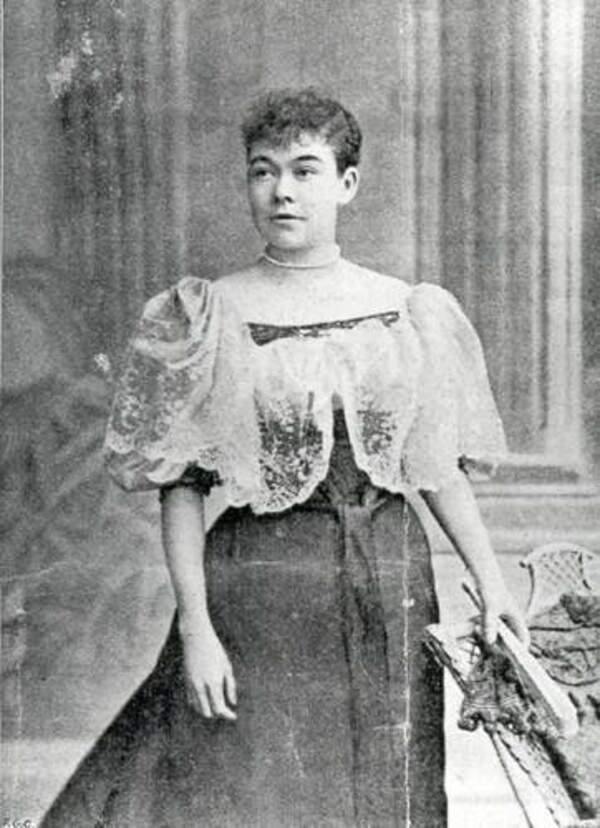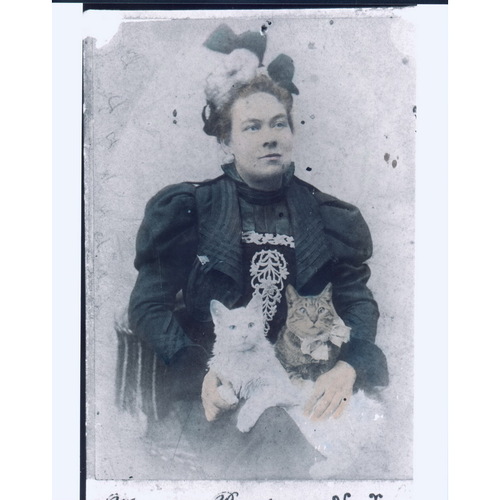
Source: Link
STIRLING, GEORGINA ANN, also known as Twillingate Stirling and Marie Toulinguet, opera singer; b. 3 April 1867 in Twillingate, Nfld, daughter of William McCleery Carrington Stirling, a physician, and Ann Peyton; d. there unmarried 21 April 1935.
Georgina Stirling, known as Georgie, was the youngest of seven sisters. Three or possibly four brothers died between infancy and ten years of age, and her mother passed away in August 1882, when Georgina was just 15. Within three months of her mother’s death, Georgina was taken to Toronto by her sister Kate Stuart Stirling. Having begun her education both privately and in the public schools of Twillingate, she was enrolled in January 1883 in the boarding and day school run by Elizabeth Frances Champion and Sidonia Berthon (daughter of the artist George Theodore Berthon*). By the spring of the following year she was also a pupil of Carl Martens, a graduate of the Royal Conservatory of Music of Leipzig, Germany, with whom she studied piano and organ. Writing about Georgina’s first organ instruction in Toronto, Kate commented that “Martens thinks one lesson a week should suffice, as she is pretty well drilled in the theory.”
Georgina had been introduced to the instrument at a young age by Hannah Elizabeth Temple, wife of Robert Temple, the rector of St Peter’s Anglican Church in Twillingate. Mrs Temple was a trained musician from Norfolk, England, and under her tutelage Georgina had begun performing as an organist before she turned 15. After observing her sister practise, which Georgina did for a minimum of four hours each day, Kate would later write to their father, “Georgie puts her whole soul into the organ.”
On 7 March 1883, two months after beginning her schooling in Toronto, Georgina heard the famous Swedish soprano Christina Nilsson sing. Following the concert she told Kate that she never could have imagined such music coming from a human being. Her own voice may well have been unremarkable at this time, but the experience seems to have sparked a deep commitment to operatic music. In 1884, having had some vocal training with Martens, she began taking lessons with Sarah Rachel Bradley, an instructor at the Ontario Ladies’ College in Whitby. “I had no idea,” Kate would remark the following year, “that she had such a beautiful voice.” When Georgina returned to Newfoundland after two and half years, the British governor of the colony, Henry Arthur Blake, happened to hear her sing. He was enthralled by her voice and insisted to her family that she should do advanced vocal studies in Europe. Others were equally convinced. John W. Cowan, a New Brunswick friend of her father, wrote to Dr Stirling about his daughter’s “rare gift,” encouraging him to send her for further training in Italy. “She’s an artist,” he commented.
In October 1888, accompanied by her sister Rosetta Elizabeth Crosse Stirling, known as Rose, Georgina left for Italy. She spent two years studying in Florence under well-known singing master Luigi Vannuccini, giving many public performances and making her operatic debut at Borgo San Donnini (Fidenza), near Parma, in the autumn of 1890. She next undertook a six-month engagement in Milan, where, it is said, she sang before Italian royalty. La Scala has been suggested by some sources as the scene of her performances, but this supposition cannot be independently confirmed.
In the spring or summer of 1891 Georgina went to London, England; her sisters Janet Mary and Lucinda may have settled there by this time. She became engaged in the concert scene with Charles Santley, an acclaimed baritone and oratorio star, and with Narcisco Vert, a famous manager and agent. She was encouraged by a small group of society women to go to Paris and audition before the renowned singer and vocal teacher Mathilde Marchesi, who reportedly said, “Yours is a voice that the world is waiting for & you will be a great great woman.” “I never dreamed of such a success,” Georgina wrote excitedly to Janet. “I was nearly paralized [sic] with pleasure.” After two years of study and performance under Marchesi, Georgina made her debut in Paris in 1893, probably in the spring and likely under the name Marie Toulinguet (the French name for Twillingate). She then returned to the concert scene in London, working with Santley, Vert, and others, sang also in Ireland, and did a concert tour in Germany and possibly took further vocal training there. The London Times in 1895 commented on her “powerful mezzo-soprano voice, of especial beauty in the upper register.”
During the summers of 1892, 1893, 1895, 1896, and 1897, Georgina visited her home in Twillingate, on each occasion spending about four months in Newfoundland. (“Twillingate Stirling loves her native land,” stated the St John’s Evening Telegram in 1896, “there can be no doubt about that.”) She gave free concerts for charitable causes, as many as 18 in 16 days at St John’s in September–October 1895, perhaps negating the benefits of the six-week rest that her medical advisers in England had prescribed for that summer. A further rest was deemed necessary after her return to London. Her generosity of time and talent in aid of charities may have been taking a toll on her voice.
By August 1896 Georgina had been engaged for a two-year period as prima donna soprano by James Henry Mapleson of the New Imperial Opera Company (she had expanded into the soprano repertoire under Marchesi). The company, which began performances in Brooklyn (New York) that October, emphasized Italian opera, in which Georgina was well schooled, but it faced fierce competition from the Metropolitan Opera of New York. In December, when the company was appearing in Boston, shaky finances obliged it to disband. Georgina was then engaged by the Boston Symphony Orchestra, singing with it in early 1897 in Washington and Brooklyn. In the 1897–98 season she was the leading soprano with the operatic company headed by Sofia Scalchi Lolli and toured extensively and to great acclaim in the United States before leaving in February 1898 and returning to Italy. In her subsequent performances at Venice, she was noted by a local newspaper to be “the favorite of the public … who is constantly applauded, if alone for her dramatic genius.” From Venice she went to the cathedral city of Chioggia to premiere a new mass setting composed and to be directed by Maestro Luigi Taccheo, who was said to have insisted that only she should sing it. Following her outstanding performance, Georgina was given a night of honour and presented with a testimonial and bouquets of flowers that concealed live doves and canaries. She had reached the very pinnacle of her singing career.
Though Georgina apparently continued to perform in Milan in 1899–1900, details of individual engagements are scarce. Late 1900 to late 1901 seems to have become a year of silence. Correspondence between her and her two sisters in London evidently ceased, as it did also with her best friends in the operatic world. This lack of communication was likely the result of a combination of vocal problems and severe distress over an unknown situation. A child was somehow involved. In March 1901 an Italian boy named Ugo Angelo Vincent, seemingly born Ugo Sterling in Milan in May 1893, was enrolled in a school near the home of Susan Peyton Temple, another Stirling sibling living in England. In the record of Temple’s burial in 1924, he was said to be “a nephew.” Although it seems unlikely that he was Georgina’s son – her schedule would not have allowed her time to deliver a child – there is little doubt that he was connected in some way to an emotional trauma that devastated her in 1900–1 and led to heavy drinking. There is also little doubt that she and her sisters felt a responsibility towards the boy. As Ugo grew up, he developed a close association with Janet Stirling, with whom he lived for a number of years.
Georgina returned from Italy to London in the fall of 1901, attempted unsuccessfully to make a comeback as a concert artist, and entered the Duxhurst Farm Colony for Female Inebriates. In 1904 she visited Newfoundland again and gave two well-received concerts at St John’s. She took refuge at Duxhurst at various times through to the 1920s, and after the death in 1928 of Janet Stirling, the last sister residing in England, she returned to the grand family home in Twillingate in early 1929 to live with Rose. In her remaining years she sang at church and community concerts, coached male quartets, helped to stage plays, taught French to high school students, and planted rosebushes and a large array of flowers from which she made bouquets for weddings and to comfort sick neighbours. She died of cancer on Easter Sunday 1935. A late winter storm deposited some six feet of snow, and it was remarked that her grave was like an ice castle, a notion that would have pleased her.
Georgina had stated that she had made only one recording of her voice and that she had had “to sing down a long horn.” It has been suggested that this event took place in 1904, but it seems more likely that it occurred in 1896 at St John’s when one R. Chappell was visiting the colony to demonstrate the graphophone developed by Alexander Graham Bell* and his associates and to capture the voices of local artists. The search continues for Georgina’s recording.
Perhaps only a novel or a movie, sensitively crafted, could do justice to Georgina Ann Stirling. When journalist Peter John Vickers Worthington* visited Twillingate in 1999 and was made aware of this remarkable woman’s life story, he commented that it was “the stuff of Hollywood, complete with fame, misfortune, recovery and inspiration.”
The main sources for the life of Georgina Ann Stirling are found in the authors’ full-length treatment, The heart’s obsession: an intimate biography of Newfoundland songstress Georgina Stirling (St John’s, 2019). See also DNLB (Cuff et al.); Encyclopedia of Nfld (Smallwood et al.), 5: 308; and A. L. Payton, Nightingale of the north (St John’s, 1983).
Cite This Article
Calvin D. Evans and Tonia Evans Cianciulli, “STIRLING, GEORGINA ANN (Twillingate Stirling, Marie Toulinguet),” in Dictionary of Canadian Biography, vol. 16, University of Toronto/Université Laval, 2003–, accessed April 27, 2025, https://www.biographi.ca/en/bio/stirling_georgina_ann_16E.html.
The citation above shows the format for footnotes and endnotes according to the Chicago manual of style (16th edition). Information to be used in other citation formats:
| Permalink: | https://www.biographi.ca/en/bio/stirling_georgina_ann_16E.html |
| Author of Article: | Calvin D. Evans and Tonia Evans Cianciulli |
| Title of Article: | STIRLING, GEORGINA ANN (Twillingate Stirling, Marie Toulinguet) |
| Publication Name: | Dictionary of Canadian Biography, vol. 16 |
| Publisher: | University of Toronto/Université Laval |
| Year of revision: | 2024 |
| Access Date: | April 27, 2025 |




